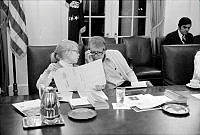Foreword; White House History Number 29
Copyright © June 01, 2011 White House Historical Association. All rights reserved under international copyright conventions. No part of this article may be reproduced or utilized in any form or by any means, electronic or mechanical, including photocopying, recording, or by any information storage and retrieval system, without permission in writing from the publisher. Requests for reprint permissions should be addressed to books@whha.org
Special spaces at the White House are usually those created by the presidents for their own use while resident there. For example, President Richard Nixon's favorite place to work alone was the Lincoln Sitting Room; First Lady Eleanor Roosevelt prepared her cozy dressing room on the opposite or west end of the home, while FDR filled the big upstairs oval room with his hobbies and books and cherished many quiet hours in its confines.
There are special spaces for retreats, for improvement of living, and for looks. This issue touches upon some that exist and some that do not. In the latter case are Clifford and Michele Krainiks never-before-published photographs of the long-vanished White House stables, and Keith MacKays return to an earlier Green Room. Mary Jo Binker takes us to that most special space, the Solarium, builds it, and traces its use by the many who loved it.

Rooms built in the attic of the North Portico during the Coolidge administration were intended for storage.
The architectural historian Travis McDonald grants that his special spaces the east and west wings are largely rebuilt but has climbed through cellar rooms ahead of the bulldozer to re-create the spaces as they descended from Jeffersons original construction. In the same vein, the architectural historian James A. Jacobs finds cause for celebration of the original White House architects skill in a tiny corner that President Harry S. Truman's reconstruction missed.
For my part, I have sketched a response to our most frequently asked question about special places in the White House: Are there secret tunnels?






























































